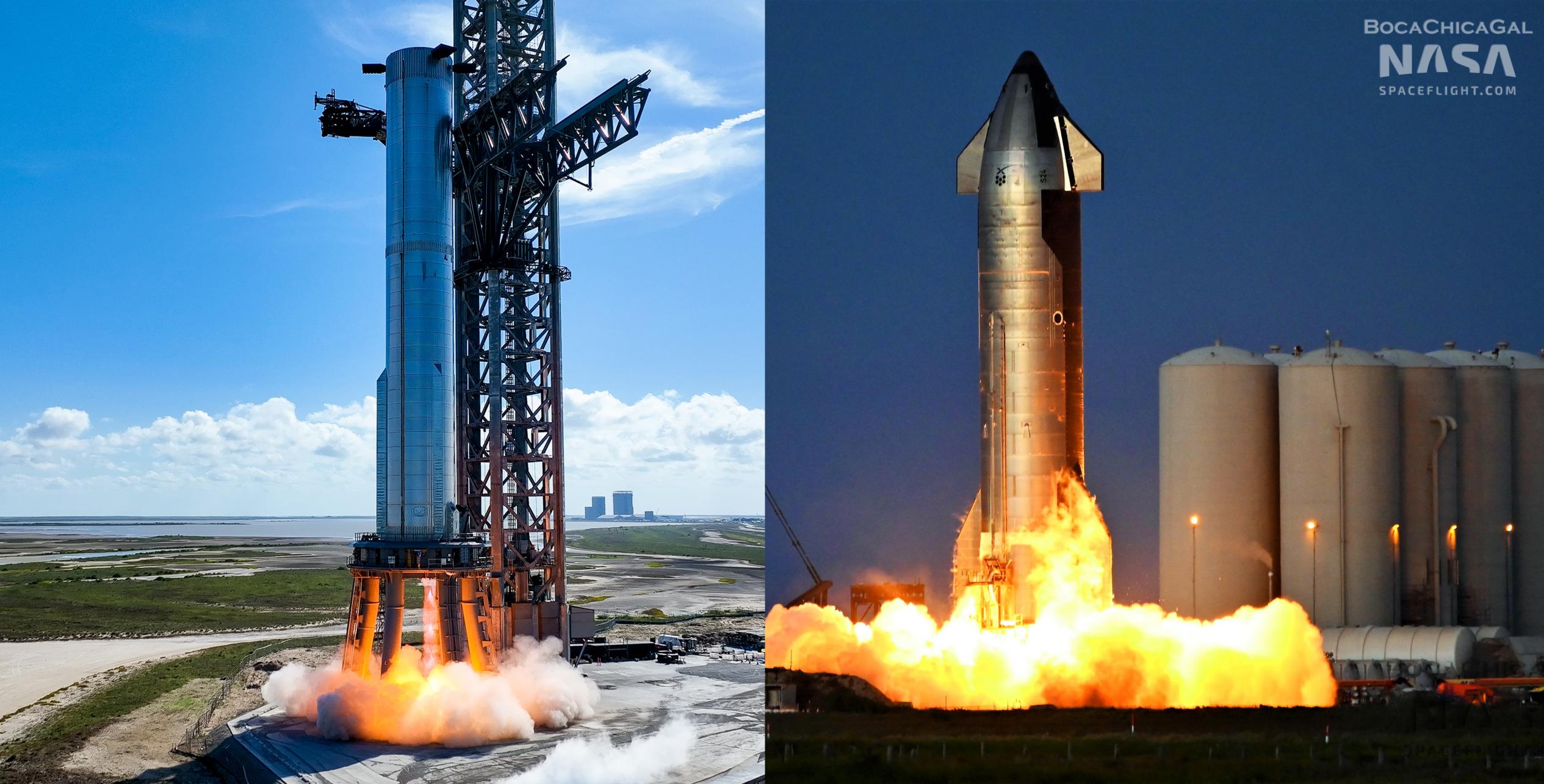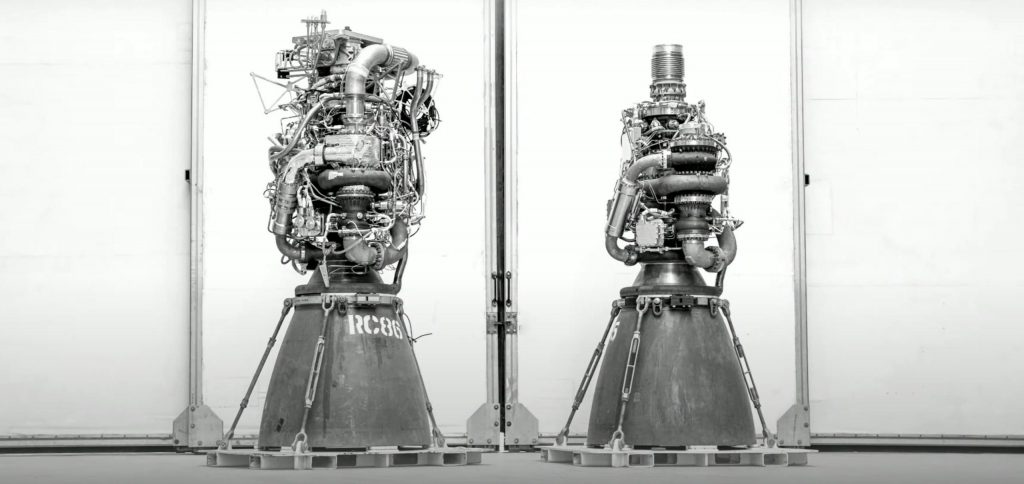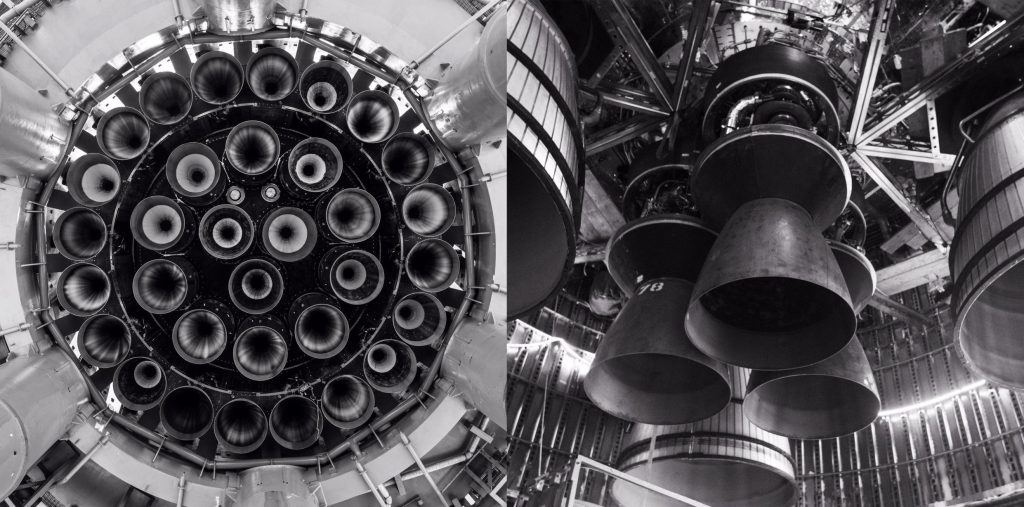

News
SpaceX preps Starship, Super Heavy for another week of Raptor testing
SpaceX continues to work around the clock to prepare its latest Starship and Super Heavy booster prototypes for another week of testing – likely focused on firing up the Raptor engines installed on each vehicle.
Known as Booster 7 and Ship 24, SpaceX has been slowly testing both prototypes for approximately four months, beginning in April and May, respectively. Only in early August did the company cautiously begin attempting to ignite their Raptor engines as part of a process known as static fire testing – by far the most difficult and important part of qualifying both vehicles for flight.
Thanks to progress made in 2021, SpaceX already has significant experience testing an earlier orbital-class Starship prototype on the ground, but the process of testing Ship 24 is still fresh and unfamiliar for a number of reasons. For Booster 7, the challenges are even greater.
On top of major design changes made to Starship and Super Heavy over the last year as SpaceX continues to refine the rocket, the company also developed a substantially different version of its Raptor engine. Compared to Raptor V1, Raptor V2 almost looks like a new engine and can produce around 25% more thrust (230 tons versus 185 tons). SpaceX has also tweaked how the engine operates, particularly around startup and shutdown, further weakening the value of past experience testing Raptor V1 and V1.5 engines on Ship 20 and Boosters 3 and 4.
In other words, with Ship 24 and Booster 7 engine testing, it’s possible that SpaceX is effectively starting from scratch. Many aspects of testing – propellant conditioning, thermal characteristics, tanking, detanking, certain test stands – are likely mostly unchanged, but almost every aspect of a rocket is affected by its engines.


Before SpaceX began testing Raptor V2 engines on Starship and booster prototypes, it wasn’t clear if the changes between V1.5 and V2 would invalidate a lot of prior testing. After the start of Booster 7 and Ship 24 static fire testing, it’s now clear that a lot of that earlier work has to be redone. It’s also clear that despite some of the simplifications in Raptor V2’s design, operating the engine on Starship and Super Heavy is much harder get get right.
Since mid-July, SpaceX has completed around 15-20 ‘spin-prime’ tests between Ship 24 and Booster 7 – more of that kind of test than any other prototype in the history of Starbase has performed. Spin-prime tests flow high-pressure gas through Raptor’s pumps to spin them up without igniting anything. It’s unclear why so many of those tests are being done, what SpaceX is gaining from it, or why the company appears to have completely stopped conducting preburner tests (a more life-like spin-prime with partial combustion).
Regardless, eight weeks after the start of engine testing, Booster 7 has only performed three static fires (two with one engine, one with a max of three or four engines), and Ship 24 has only completed one static fire with two engines. Before either vehicle can be considered ready for flight, a day that could easily never come, each will likely need to conduct multiple successful static fires with all of their Raptor engines (6 on S24 and 33 on B7).
If the pace of Booster 7 testing doesn’t change, the vehicle could be months away from a full 33-engine static fire attempt – perhaps the single most important and uncertain test standing between SpaceX and Starship’s first orbital launch attempt. Ship 24’s path to flight readiness should be simpler, but it appears to be struggling almost as much.
According to CEO Elon Musk, “an intense effort is underway” to ensure that Super Heavy B7’s Raptor engines are well contained during anomalies, so that one engine violently failing won’t damage or destroy the booster, other engines, or the launch pad. That could certainly complicate the process of testing Booster 7, and it’s likely that SpaceX is taking some of the same actions to protect Ship 24.
In early September, after a partially successful Booster 7 static fire (its first multi-engine test) and numerous additional Ship 24 tests that failed to achieve ignition, SpaceX replaced engines on both vehicles. Booster 7 had one of 13 Raptor Center engines swapped out, while Ship 24 had one of its three Raptor Vacuum engines replaced.
On September 5th, SpaceX distributed a safety alert to Boca Chica’s few remaining residents, confirming that it wants to restart testing as early as Tuesday, September 6th. Especially as of late, that alert guarantees nothing, but it does at least open the door for SpaceX if Ship 24, Booster 7, and the positions of the stars happen to be in the right mood between 8am and 8pm CDT. Additional opportunities are available on September 7th, 8th, 9th, and 12th.

Elon Musk
Elon Musk and Tesla AI Director share insights after empty driver seat Robotaxi rides
The executives’ unoccupied tests hint at the rapid progress of Tesla’s unsupervised Robotaxi efforts.

Tesla CEO Elon Musk and AI Director Ashok Elluswamy celebrated Christmas Eve by sharing personal experiences with Robotaxi vehicles that had no safety monitor or occupant in the driver’s seat. Musk described the system’s “perfect driving” around Austin, while Elluswamy posted video from the back seat, calling it “an amazing experience.”
The executives’ unoccupied tests hint at the rapid progress of Tesla’s unsupervised Robotaxi efforts.
Elon and Ashok’s firsthand Robotaxi insights
Prior to Musk and the Tesla AI Director’s posts, sightings of unmanned Teslas navigating public roads were widely shared on social media. One such vehicle was spotted in Austin, Texas, which Elon Musk acknowleged by stating that “Testing is underway with no occupants in the car.”
Based on his Christmas Eve post, Musk seemed to have tested an unmanned Tesla himself. “A Tesla with no safety monitor in the car and me sitting in the passenger seat took me all around Austin on Sunday with perfect driving,” Musk wrote in his post.
Elluswamy responded with a 2-minute video showing himself in the rear of an unmanned Tesla. The video featured the vehicle’s empty front seats, as well as its smooth handling through real-world traffic. He captioned his video with the words, “It’s an amazing experience!”
Towards Unsupervised operations
During an xAI Hackathon earlier this month, Elon Musk mentioned that Tesla owed be removing Safety Monitors from its Robotaxis in Austin in just three weeks. “Unsupervised is pretty much solved at this point. So there will be Tesla Robotaxis operating in Austin with no one in them. Not even anyone in the passenger seat in about three weeks,” he said. Musk echoed similar estimates at the 2025 Annual Shareholder Meeting and the Q3 2025 earnings call.
Considering the insights that were posted Musk and Elluswamy, it does appear that Tesla is working hard towards operating its Robotaxis with no safety monitors. This is quite impressive considering that the service was launched just earlier this year.
Elon Musk
Starlink passes 9 million active customers just weeks after hitting 8 million
The milestone highlights the accelerating growth of Starlink, which has now been adding over 20,000 new users per day.

SpaceX’s Starlink satellite internet service has continued its rapid global expansion, surpassing 9 million active customers just weeks after crossing the 8 million mark.
The milestone highlights the accelerating growth of Starlink, which has now been adding over 20,000 new users per day.
9 million customers
In a post on X, SpaceX stated that Starlink now serves over 9 million active users across 155 countries, territories, and markets. The company reached 8 million customers in early November, meaning it added roughly 1 million subscribers in under seven weeks, or about 21,275 new users on average per day.
“Starlink is connecting more than 9M active customers with high-speed internet across 155 countries, territories, and many other markets,” Starlink wrote in a post on its official X account. SpaceX President Gwynne Shotwell also celebrated the milestone on X. “A huge thank you to all of our customers and congrats to the Starlink team for such an incredible product,” she wrote.
That growth rate reflects both rising demand for broadband in underserved regions and Starlink’s expanding satellite constellation, which now includes more than 9,000 low-Earth-orbit satellites designed to deliver high-speed, low-latency internet worldwide.
Starlink’s momentum
Starlink’s momentum has been building up. SpaceX reported 4.6 million Starlink customers in December 2024, followed by 7 million by August 2025, and 8 million customers in November. Independent data also suggests Starlink usage is rising sharply, with Cloudflare reporting that global web traffic from Starlink users more than doubled in 2025, as noted in an Insider report.
Starlink’s momentum is increasingly tied to SpaceX’s broader financial outlook. Elon Musk has said the satellite network is “by far” the company’s largest revenue driver, and reports suggest SpaceX may be positioning itself for an initial public offering as soon as next year, with valuations estimated as high as $1.5 trillion. Musk has also suggested in the past that Starlink could have its own IPO in the future.
News
NVIDIA Director of Robotics: Tesla FSD v14 is the first AI to pass the “Physical Turing Test”
After testing FSD v14, Fan stated that his experience with FSD felt magical at first, but it soon started to feel like a routine.

NVIDIA Director of Robotics Jim Fan has praised Tesla’s Full Self-Driving (Supervised) v14 as the first AI to pass what he described as a “Physical Turing Test.”
After testing FSD v14, Fan stated that his experience with FSD felt magical at first, but it soon started to feel like a routine. And just like smartphones today, removing it now would “actively hurt.”
Jim Fan’s hands-on FSD v14 impressions
Fan, a leading researcher in embodied AI who is currently solving Physical AI at NVIDIA and spearheading the company’s Project GR00T initiative, noted that he actually was late to the Tesla game. He was, however, one of the first to try out FSD v14.
“I was very late to own a Tesla but among the earliest to try out FSD v14. It’s perhaps the first time I experience an AI that passes the Physical Turing Test: after a long day at work, you press a button, lay back, and couldn’t tell if a neural net or a human drove you home,” Fan wrote in a post on X.
Fan added: “Despite knowing exactly how robot learning works, I still find it magical watching the steering wheel turn by itself. First it feels surreal, next it becomes routine. Then, like the smartphone, taking it away actively hurts. This is how humanity gets rewired and glued to god-like technologies.”
The Physical Turing Test
The original Turing Test was conceived by Alan Turing in 1950, and it was aimed at determining if a machine could exhibit behavior that is equivalent to or indistinguishable from a human. By focusing on text-based conversations, the original Turing Test set a high bar for natural language processing and machine learning.
This test has been passed by today’s large language models. However, the capability to converse in a humanlike manner is a completely different challenge from performing real-world problem-solving or physical interactions. Thus, Fan introduced the Physical Turing Test, which challenges AI systems to demonstrate intelligence through physical actions.
Based on Fan’s comments, Tesla has demonstrated these intelligent physical actions with FSD v14. Elon Musk agreed with the NVIDIA executive, stating in a post on X that with FSD v14, “you can sense the sentience maturing.” Musk also praised Tesla AI, calling it the best “real-world AI” today.








